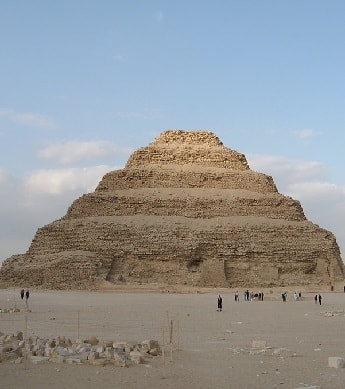Introduction - Step Pyramid
Egyptian step pyramids were created during Egypt's third dynasty. These were the earliest type of Egyptian pyramids and were the predecessors of the "true pyramids" built with smooth sides. What defines a step pyramid is the use of a series of flat platforms on top of one another where they gradually get smaller as they get to the top. King Djoser, who reigned over Egypt for at least 19 years around 2670 B.C, was the first royal figure to have a step pyramid built for him. The below list of facts and interesting information about the Egyptian step pyramids is written in a kid friendly format so anyone researching step pyramids can truly understand why they are such extraordinary works of art.Click here for a great selection of Amazon.com books about Ancient Egyptian Pyramids.
Egyptian Step Pyramid General Facts
- A step pyramid is a series of flat platforms, also called mastabas that were typically made of stone. The structures rise above the ground with the largest platform being the base and the smallest platform at the top of the pyramid.
- Egyptian step pyramids were created to serve as elaborate burial grounds for royalty.
- After the famous Egyptian step pyramid that King Djoser had created, no other Egyptian Step pyramid was fully completed.
- The era of Egyptian step pyramids came to an end when true pyramids began being built in their place during the 4th dynasty.
Djoser's Egyptian Step Pyramid Facts
- The step pyramid King Djoser had built was considered the first "skyscraper" at 254 feet tall (77.4 meters). His work was so astonishing that centuries later he was worshipped as a deity.
- The person believed to have constructed the step pyramid for Djoser was a master architect and engineer by the name of Imhotep.
- Because of its complex and revolutionary design, Djoser's pyramid is considered one of the most prominent architectural advancements in the history of the world.
- Built in the 27th century BC, Djoser's pyramid is twice as old as the Roman Forum.
- Djoser's pyramid has six complete steps which are constructed of white limestone.
- In 1934, pyramid expert and architect, Jean-Philippe Lauer, excavated Djoser's tomb which lay 95 feet below the surface of the pyramid. He discovered Djoser's mummified left foot.
Recently Discovered Egyptian Step Pyramid
- On February 3, 2014, archaeologists unearthed a 4,600 year old Egyptian step pyramid in Edfu, which was once believed to have stood about 43 feet high (13 meters).
- Weathering and pillaging have taken a toll on the ancient structure and it now stands at about 16 feet (5 meters) tall.
- What is remaining of the 4,600 year old structure is older than the Great Pyramid in Giza.
Egyptian Provincial Step Pyramid Facts
- The newly discovered step pyramid in Edfu is part of the group of pyramids called provincial pyramids that were either built by the pharaoh Huni or Snefru.
- The provincial pyramids are a group of seven step pyramids that have very similar characteristics and dimensions and were built in settlements throughout central and southern Egypt around the same time period.
- No one knows the exact reason for the provincial pyramids creation but some experts speculate that they may have been created as symbolic monuments.
